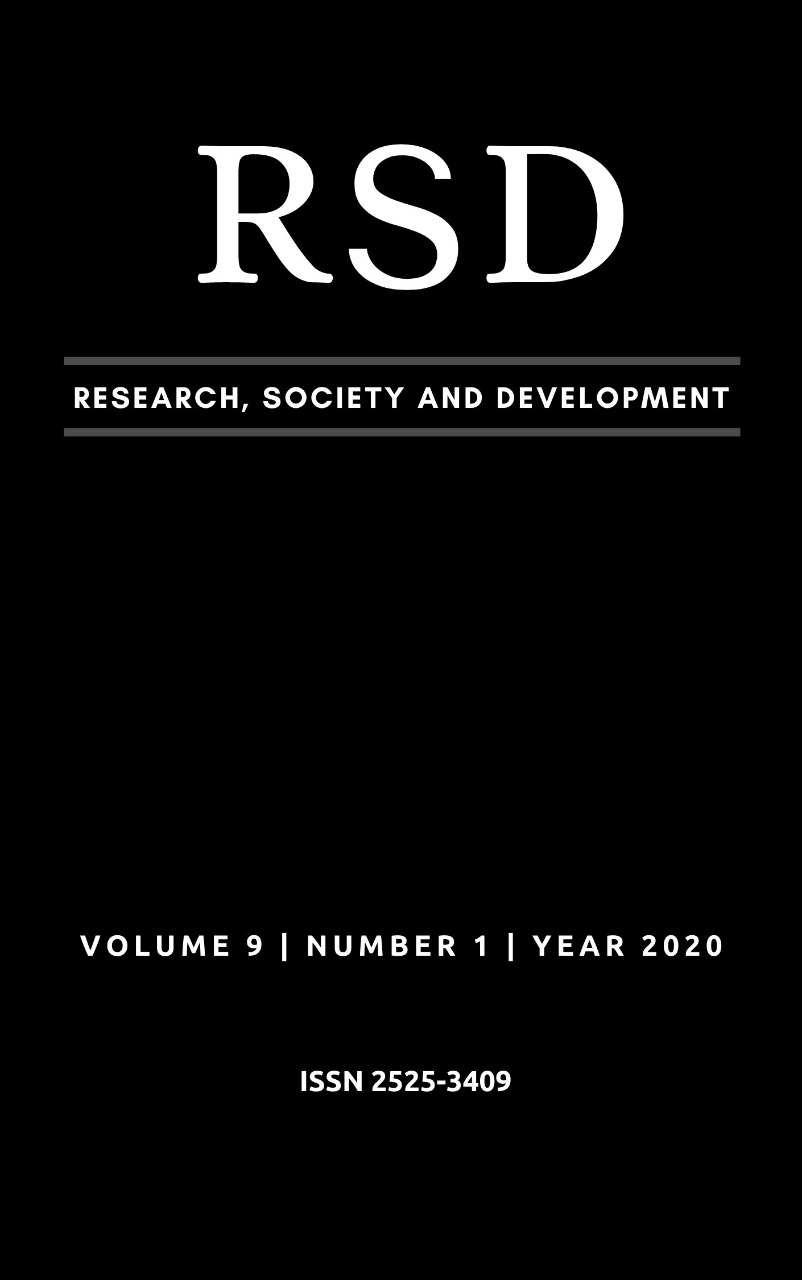Perfil nutricional de usuários de entorpecentes em tratamento em um estado da região nordeste
DOI:
https://doi.org/10.33448/rsd-v9i1.1506Palavras-chave:
Estado Nutricional, Consumo de Alimentos, Adultos.Resumo
Introdução: O uso abusivo de drogas é um problema relevante em saúde publica. Tendo em vista os prejuízos causados aos usuários pelo abuso dessas substâncias. Objetivo: Conhecer o perfil nutricional de dependentes químicos em tratamento, de forma a contribuir para um cuidado nutricional efetivo. Método: Foram coletados dados antropométricos (peso e estatura) para avaliação de Índice de Massa Corporal, bem como foi aplicado um questionário de frequência alimentar para verificação de seus hábitos alimentares. Resultados: A maioria dos indivíduos em tratamento encontrava-se na faixa etária entre 31 a 40 anos, e estavam eutróficos. Observaram-se alguns casos de sobrepesos e apenas um indivíduo apresentava obesidade, que pode ser explicado pelo aumento do consumo de alimentos energéticos em detrimento de baixo consumo de frutas e legumes. Conclusão: O perfil nutricional dos dependentes químicos em tratamento na instituição avaliada transitou entre a eutrofia e o excesso de peso, sendo um sugestivo ao consumo aumentado de alimentos, possivelmente em substituição à droga, como uma compensação.
Referências
Baldissera L, Zanon KM, Tonini C, Teo CRPA. (2007). Risco de desenvolvimento de obesidade durante o tratamento da dependência química. Anais do XI Seminário de Iniciação Científica, IV Seminário de Pesquisa, II Seminário de Extensão; 1 CD.
Brasil. (2011). Orientações para a coleta e análise de dados antropométricos em serviços de saúde: Norma Técnica do Sistema de Vigilância Alimentar e Nutricional - SISVAN/ Brasília: Ministério da Saúde. 76 p
Duarte AC. (2007). Avaliação nutricional: aspectos clínicos e laboratoriais. São Paulo: Atheneu.
Ferreira IB, Paiva CB, Narvaez JCM, Bosa VL. (2015). Estado nutricional e hábitos alimentares de dependentes químicos em tratamento ambulatorial. J Bras Psiquiatr. 64(2):146-53.
Migott AMB. (2008). Dependência química: problema biológico, psicológico ou social? Cad Saúde Pública. 24(3):710-1.
Ministério da Saúde. (2014). Secretaria de Atenção à Saúde; Departamento de Atenção Básica. Guia alimentar para a população brasileira. 2ª ed. Brasília.
Oliveira ERN, Marin IC, Feruzzi L, Tenório MFS, Trindade E. (2005). Avaliação dos hábitos alimentares e dos dados antropométricos de dependentes químicos. Arquivos de Ciências da Saúde da Unipar. 9(2):91-6
Quimelli GAS, Krainski LB, Cordeiro MS. (2008). Perfil dos usuários dependentes de drogas do programa Nutrição Brasil - pró-egresso (PPE) de Ponta Grossa. Revista Conexão UEPG. 3:54-8.
Reis NT. (2003). Nutrição clínica: alcoolismo. Rio de Janeiro: Rubio.
Senger AEV, et al. (2011). Alcoolismo e tabagismo em idosos: relação com ingestão alimentar e aspectos socioeconômicos. Rev. Bras. Geriatr. Gerontol., Rio de Janeiro. 14 (4): 713-719.
Silva EA, Micheli D, Camargo BMV, Buscatti D, Alencar MAP, Formigoni MLOS. (2006). Drogas na adolescência: temores e reações dos pais. Psicologia: teoria e prática. 8(1): 214-22.
Teo CRPA, Baldissera L, Rech FRF. (2011). Adequação da alimentação ao perfil dos dependentes químicos em uma comunidade terapêutica: um estudo de caso. SMAD Rev Eletrônica Saúde Mental Álcool Drog. 7(3):199-25.
Toffolo MCF, et al. (2011). Escolha de alimentos durante a abstinência alcoólica: influência na fissura e no peso corporal. J. Bras. Psiquiatr. Rio de Janeiro. 60 (4): 341-346.
Willhelm FF, Escobar M, Perry ID. (2013). Alterações na composição corporal e em parâmetros antropométricos de dependentes de crack internados em unidade de adição. J. Bras. Psiquiatr., Rio de Janeiro. 62 (3): 183-190.
Who. World Health Organization. (2000). Obesity: preventing and managing the global epidemic: report of a WHO consultation on obesity. WHO. (WHO Technical Report Series n. 894).
Zeferino MT, Santos VEP, Radünz V, Carraro TE, Frello AT. (2006). Enfermeiros e uso abusivo de drogas: comprometendo o cuidado de si e do outro. Rev Enferm UERJ. 14(4):599-606
Downloads
Publicado
Edição
Seção
Licença
Autores que publicam nesta revista concordam com os seguintes termos:
1) Autores mantém os direitos autorais e concedem à revista o direito de primeira publicação, com o trabalho simultaneamente licenciado sob a Licença Creative Commons Attribution que permite o compartilhamento do trabalho com reconhecimento da autoria e publicação inicial nesta revista.
2) Autores têm autorização para assumir contratos adicionais separadamente, para distribuição não-exclusiva da versão do trabalho publicada nesta revista (ex.: publicar em repositório institucional ou como capítulo de livro), com reconhecimento de autoria e publicação inicial nesta revista.
3) Autores têm permissão e são estimulados a publicar e distribuir seu trabalho online (ex.: em repositórios institucionais ou na sua página pessoal) a qualquer ponto antes ou durante o processo editorial, já que isso pode gerar alterações produtivas, bem como aumentar o impacto e a citação do trabalho publicado.


